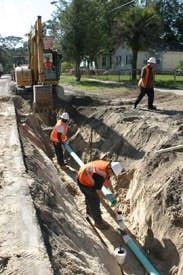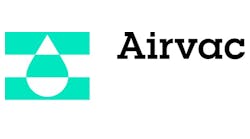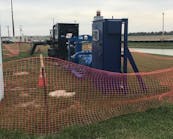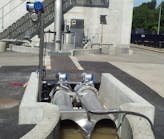Airvac
undefinedVacuum sewers provide a low-maintenance solution for a Florida utilityPublic utilities face expensive choices. They often manage enormous budgets and make multimillion-dollar decisions. A good choice will serve their customers well for decades, maybe even generations. A poor choice will waste money and create recurring headaches for years.
JEA, the electric, water and sewer utility for the Jacksonville, Fla., area, serves hundreds of thousands of customers. The utility has been around for more than 100 years and has firsthand experience with many processes and technologies common to public works professionals. The management takes a pragmatic approach when it comes to wastewater conveyance, and it has used virtually every wastewater system there is, so it knows what works best in specific situations.
“Our policy is that we will use vacuum sewers in areas where there is a very high groundwater table, where the terrain is relatively flat and where there is fairly dense development,” said Colin Groff, P.E., director of support services for JEA.
JEA has four AIRVAC vacuum sewer systems in its service area, as well as an extensive gravity sewer network with 1,300 gravity lift stations. Since the installation of the systems, the company has learned the benefits of vacuum technology in areas where trenching is difficult or where flat ground requires multiple pumping stations. Its most recent vacuum system, in the Lake Forest area, serves about 850 homes and requires only one vacuum pumping station.
The Lake Forest system, which was manufactured by AIRVAC of Rochester, Ind., was installed to replace hundreds of septic tanks in the area that were leaching wastewater into the environment.
“From an environmental standpoint, vacuum sewers are very tight systems,” Groff said. “They don’t allow any contaminants to escape.”
Vacuum sewers are a “closed” system; there is no infiltration or exfiltration, so they prevent sewage from escaping or groundwater from entering. If a break occurs in a vacuum line, the contents remain in the pipe due to the negative pressure within the pipe.
Vacuum collection lines require little slope, so deep installation trenches are unnecessary. In areas of high groundwater, this greatly reduces the need for dewatering and trench shoring. It also eliminates the need for large excavation equipment and reduces traffic disruption. This is especially important in developed neighborhoods where heavy equipment, workers, traffic detours and service rerouting create significant headaches for public works directors.
Ease of installation and repair are important, but those are only a few of the benefits of a closed system.
“What I like about vacuum sewers is that odors are contained,” said Chuck Martin, the utility’s maintenance coordinator. “Gravity sewers have lots of places where odors can escape. I also like the fact that vacuum mains tend to clean themselves. The speed of the wastewater in the lines scours the pipes.” Martin also noted that leaks are rare in a vacuum system and that when they do occur, they are usually easy to find.
“With our AIRVAC system , you always know if you have any infiltration or exfiltration because we have system monitoring at the vacuum station,” he said. “In a gravity system, you may have to run a camera in the sewer main for days to find a leak.”
The shallow burial depth, typically 4 to 6 ft, simplifies finding and repairing leaks. Repairing a broken vacuum main usually takes only a few hours. Operations and maintenance are huge cost items for public utilities. Public works directors tend to think long term when considering technology options for their districts, so when JEA first considered a vacuum sewer system, there was skepticism from some personnel about how much time and money would be required to keep the sewers flowing properly.
“I’ve been with JEA for 22 years. It was all force-main gravity sewers until a few years ago when we started hearing about vacuum sewers,” said Phil Yeatman, a maintenance coordinator for JEA. “Vacuum sewers present a different theory on how to move fluids. The Scott Mill area, one of the areas where we installed them, is basically a swamp. It would have a cost too much to install gravity lines there, so we looked at vacuum technology as an alternative.”
Most of JEA’s staff had limited knowledge of vacuum sewers prior to the Scott Mill installation, so there was some understandable anxiety about O&M issues.
“My first thought was that it would be like a grinder pump system; every customer would have a unit in their yard that would require electricity, have mechanical parts, a pump, a float and an alarm; a very labor intensive set-up,” Yeatman said. “But with a vacuum sewer, you have none of that.”
Yeatman noted that a single vacuum valve pit will serve two or three homes and that vacuum valves operate pneumatically, so no electricity is required. JEA’s Martin said that he first assumed he would need at least two or three men dedicated to daily vacuum sewer maintenance, but that has not been the case. One workman is assigned to check the vacuum station each day for routine maintenance, which usually takes 15 to 30 minutes.
“The vacuum station is clean and odor free, so it’s an easy assignment,” he said. “Sometimes, when I’m out and about, I take my lunch in the vacuum station. It is air conditioned, so you can get out of the weather and use it as an office.”
JEA personnel were trained in vacuum sewer operation and maintenance by AIRVAC .
“They were very thorough," Martin said. "We do regular maintenance on the vacuum pumps about once a week. I can’t recall a single instance where we’ve had to repair any part of the vacuum sewer infrastructure.”
JEA’s vacuum systems are equipped with a back-up generator. If power is lost, the generator can keep the system operational until power is restored. For coastal cities like Jacksonville, which are susceptible to hurricanes, this is a valuable benefit. Vacuum mains also prevent storm water intrusion, which can overwhelm treatment facilities and run up treatment costs.
Experience has taught JEA the value of vacuum sewers in certain applications. It is now comfortable choosing vacuum technology and has no reservations about using it when the situation is right.
“It is simply a different way to look at moving liquids,” Yeatman said. “It is safer to work on. It is self contained. It is less labor intensive. There are plenty of good things you can say about a vacuum sewer system.”



